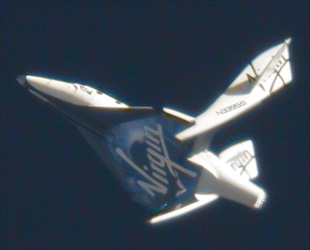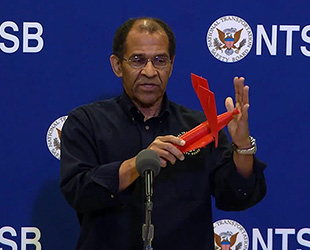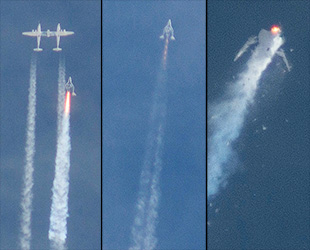November 3, 2014- Virgin Galactic's SpaceShipTwo broke apart in flight two seconds after its tail booms prematurely deployed into their upright position, an orientation that was only intended for after the spacecraft's hybrid rocket motor had cut off, government investigators revealed on Sunday (Nov. 2).
The "uncommanded feather" was partially the result of the ship's co-pilot, Michael Alsbury, moving a lever inside the cockpit from the lock to unlock position. Alsbury, 39, died in the resulting crash. Pilot Peter Siebold, 43, survived the accident, but with serious injuries.
Meeting for a second day of its investigation, the National Transportation Safety Board's (NTSB) Go-Team continued surveying the SpaceShipTwo debris where it fell across a five-mile (8-kilometer) stretch of California's Mojave desert on Friday (Oct. 31).

Telescopic view of Virgin Galactic's SpaceShipTwo feathering its tail booms during its first test flight of the braking system in May 2011. (Clay Center Observatory/Virgin Galactic) |
"They found the fuel tanks, oxidizer tanks and the engine" Christopher Hart, acting chairman of the NTSB, said. "All were intact and showed no signs of burn-through, no signs of being breached."
Early public speculation about the cause of the crash had focused on SpaceShipTwo's reformulated rocket engine, a new polyamide based fuel grain, which was being tested in flight for the first time when the vehicle was lost.
Instead, while reviewing the telemetry and video data, the investigators found the feathers had deployed in the wrong position at the wrong time.
"About 9 seconds after the engine ignited, telemetry data showed that the feather parameters changed from lock to unlock," Hart stated. "In order for feathering — this action to be commanded by the pilots — two actions must occur: the lock/unlock lever must be moved from lock to unlock, and the feathering handle must be moved to the feather position."
A video camera mounted above SpaceShipTwo's cockpit captured footage of Alsbury moving the lever to the unlock position. The feathering handle was not moved.

Christopher Hart, National Transportation Safety Board chairman, explains how SpaceShipTwo feathers using a model. (NTSB) |
"Normal launch procedures are that after the release [from the carrier aircraft WhiteKnightTwo], ignition of the rocket and the acceleration, that the feathering devices are not to be moved," Hart said. "The lock/unlock lever is not to be moved into the unlock position until the acceleration up to Mach 1.4. Instead, it occurred approximately at Mach 1."
Investigators don't yet know why Alsbury moved the lever when he did. Telemetry showed that the engine burn was normal up until the extension of the feathers.
Hart stressed to reporters that the findings about the lever position and uncommanded feathering were statements of fact, rather than a conclusion about what had caused the vehicle to crash.
"We are a long way from finding cause," he said. "We still have months and months of investigation to do [and] a lot we don't know."
Hart stated that the NTSB was not ruling out pilot error, or any other consideration with regard to the cause.

Photographs captured SpaceShipTwo breaking apart after firing its new hybrid rocket engine. (Kenneth Brown/USA Today) |
Virgin Galactic officials reiterated on Sunday that "now is not the time for speculation."
"Now is the time to focus on all [of] those affected by this tragic accident and to work with the experts at the NTSB, to get to the bottom of what happened on that tragic day, and to learn from it so that we can move forward safely with this important mission," the space tourism company said in a statement.
Virgin Galactic, along with Scaled Composites, has been developing SpaceShipTwo since 2004 to fly two pilots and six passengers on suborbital spaceflights. More than 800 people have paid up to $250,000 to fly on the spacecraft, which up until the crash had been slated to enter service next year.
